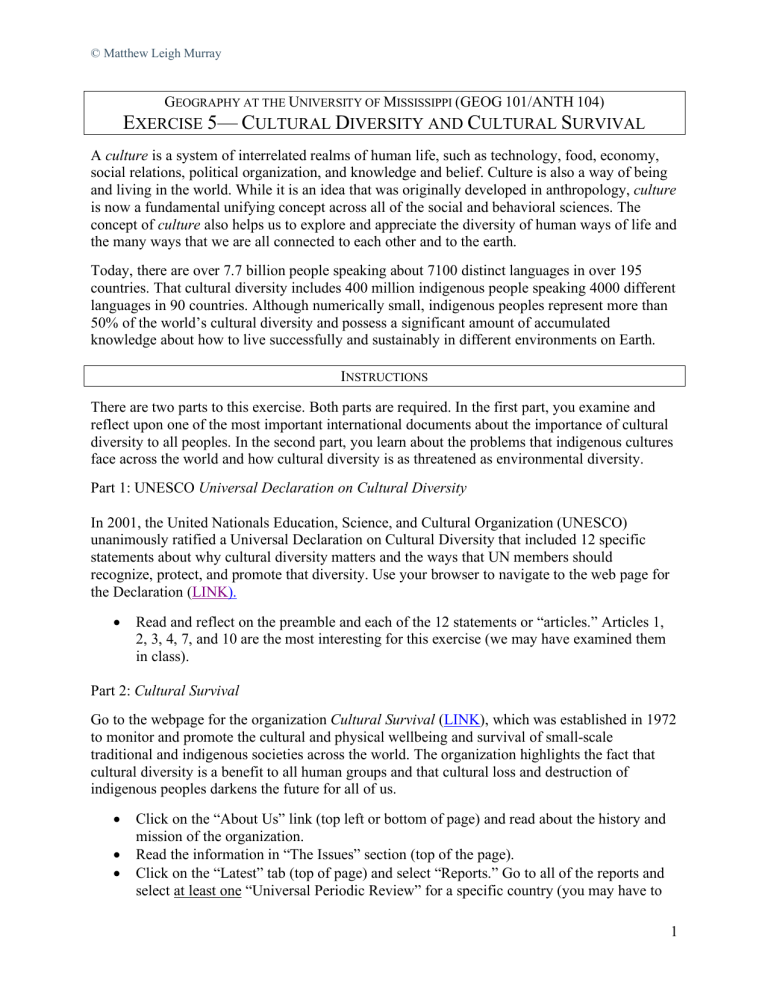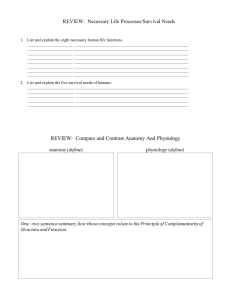Cultural Diversity & Survival Exercise: UNESCO & Indigenous Issues
advertisement

© Matthew Leigh Murray GEOGRAPHY AT THE UNIVERSITY OF MISSISSIPPI (GEOG 101/ANTH 104) EXERCISE 5— CULTURAL DIVERSITY AND CULTURAL SURVIVAL A culture is a system of interrelated realms of human life, such as technology, food, economy, social relations, political organization, and knowledge and belief. Culture is also a way of being and living in the world. While it is an idea that was originally developed in anthropology, culture is now a fundamental unifying concept across all of the social and behavioral sciences. The concept of culture also helps us to explore and appreciate the diversity of human ways of life and the many ways that we are all connected to each other and to the earth. Today, there are over 7.7 billion people speaking about 7100 distinct languages in over 195 countries. That cultural diversity includes 400 million indigenous people speaking 4000 different languages in 90 countries. Although numerically small, indigenous peoples represent more than 50% of the world’s cultural diversity and possess a significant amount of accumulated knowledge about how to live successfully and sustainably in different environments on Earth. INSTRUCTIONS There are two parts to this exercise. Both parts are required. In the first part, you examine and reflect upon one of the most important international documents about the importance of cultural diversity to all peoples. In the second part, you learn about the problems that indigenous cultures face across the world and how cultural diversity is as threatened as environmental diversity. Part 1: UNESCO Universal Declaration on Cultural Diversity In 2001, the United Nationals Education, Science, and Cultural Organization (UNESCO) unanimously ratified a Universal Declaration on Cultural Diversity that included 12 specific statements about why cultural diversity matters and the ways that UN members should recognize, protect, and promote that diversity. Use your browser to navigate to the web page for the Declaration (LINK). • Read and reflect on the preamble and each of the 12 statements or “articles.” Articles 1, 2, 3, 4, 7, and 10 are the most interesting for this exercise (we may have examined them in class). Part 2: Cultural Survival Go to the webpage for the organization Cultural Survival (LINK), which was established in 1972 to monitor and promote the cultural and physical wellbeing and survival of small-scale traditional and indigenous societies across the world. The organization highlights the fact that cultural diversity is a benefit to all human groups and that cultural loss and destruction of indigenous peoples darkens the future for all of us. • • • Click on the “About Us” link (top left or bottom of page) and read about the history and mission of the organization. Read the information in “The Issues” section (top of the page). Click on the “Latest” tab (top of page) and select “Reports.” Go to all of the reports and select at least one “Universal Periodic Review” for a specific country (you may have to 1 © Matthew Leigh Murray scroll down the page). Read the information about the status of indigenous peoples in that country or region. Start with the “Executive Summary” and then examine the “Background” and “Recommendations” sections. As you investigate the Cultural Survival webpage, reflect on the UNESCO Universal Declaration on Cultural Diversity (Part 1). Written Report Write a formal paper that discusses the following prompts. Be sure to use and cite the organization’s webpage, the Universal Periodic Review, and the UNESCO declaration. 1. What is the organization Cultural Survival? 2. What do you think about the goals of the organization? How do the goals reflect the main ideas and statements in the UNESCO Universal Declaration on Cultural Diversity (2001)? 3. What are some of the main issues that impact traditional and indigenous societies across the world? What can be done to help them and to enhance their survival? 4. Which “Universal Period Review(s)” did you read and what did you learn? 5. In what way has this knowledge changed the way that you think about the world’s cultural mosaics and about the existential condition of indigenous peoples? 2



